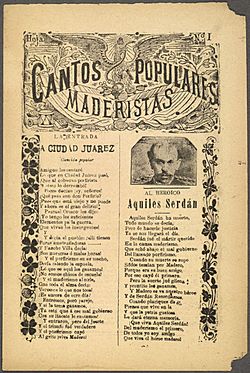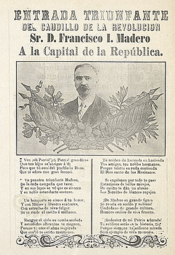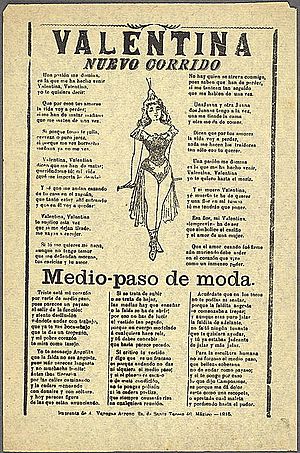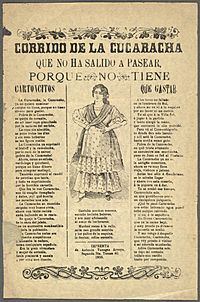Corrido facts for kids
The corrido (Spanish pronunciation: [koˈriðo]) is a famous narrative metrical tale and poetry that forms a ballad. The songs are often about oppression, history, daily life for criminals, the vaquero lifestyle, and other socially relevant topics. Corridos were widely popular during the Mexican Revolution and in the Southwestern American frontier as it was also a part of the development of Tejano and New Mexico music, which later influenced Western music.
The corrido derives mainly from the romance and, in its most known form, consists of a salutation from the singer, a prologue to the story, the story itself, and a moral and farewell from the singer. In Mexico, it is still a popular genre today.
Outside Mexico, corridos are popular in Chilean national celebrations of Fiestas Patrias.
Contents
History
Corridos play an essential part in Mexican and Mexican American culture. The name comes from the Spanish word correr ("to run"). A typical corrido's formula is eight quatrains with four to six lines containing eight syllables. Corridos have a long history in Mexico, starting from the Mexican War of Independence in 1810 and throughout the Mexican Revolution. Until the arrival and success of electronic mass media (mid-20th century), the corrido served in Mexico as the leading informational and educational outlet, even with subversive purposes, due to an apparent linguistic and musical simplicity that lent itself to oral transmission. After the spread of radio and television, the genre evolved into a new stage and is still in maturation. Some scholars, however, consider the corrido dead or moribund in more recent times (see, e.g. Vicente T. Mendoza, El corrido mexicano, 1954). In more rural areas where Spanish and Mexican cultures have been preserved because of isolation, the romance has also taken on other forms related to the corrido. In New Mexico, for example, a story-song emerged during the colonial period known as an Indita, which loosely follows the format of a corrido, but is chanted rather than sung, similar to a Native American chant, hence the name Indita.
The earliest living specimens of corrido are adapted versions of Spanish romances or European tales, mainly about disgraced or idealized love or religious topics. These, which include (among others) "La Martina" (an adaptation of the romance "La Esposa Infiel") and "La Delgadina", show the same basic stylistic features of the later mainstream corridos (1/2 or 3/4 tempo and verso menor lyric composing, meaning verses of eight or less phonetic syllables, grouped in strophes of six or fewer verses).
Beginning with the Mexican War of Independence (1810–1821) and culminating during the Mexican Revolution (1910–1921), the genre flourished and acquired its "epic" tones, along with the three-step narrative structure as described above.
Some corridos are love stories. These are not exclusively male; there are also corridos about women, such as La Venganza de Maria, Laurita Garza, El Corrido de Rosita Alvirez and La Adelita, or couples, such as La Fama de la Pareja sung by Los Tigres del Norte. Some even employ fictional stories invented by their composers.
Before the widespread use of radio, popular corridos were passed around as an oral tradition, often to spread the news of events (for example, La cárcel de Cananea) and famous heroes and humour to the population, many of whom were illiterate before the post-Revolution improvements to the educational system. The academic study of corridos written during the Revolution shows that they were used to communicate news throughout Mexico as a response to the propaganda being spread in the newspapers, which the corrupt government of Porfirio Díaz owned. Sheet music of popular corridos was sold or included in publications. Other corrido sheets were passed out free as a form of propaganda to eulogize leaders, armies, and political movements or, in some cases, to mock the opposition. The best-known Revolutionary corrido is "La Cucaracha", an old song rephrased to celebrate the exploits of Pancho Villa's army and poke fun at his nemesis Victoriano Huerta.
With the consolidation of "Presidencialismo" (the political era following the Mexican Revolution) and the success of electronic mass media, the corrido lost its primacy as a mass communication form, becoming part of a folklorist cult in one branch and, in another, the voice of the new subversives: oppressed workers, leftist activists and emigrated farm workers (mainly to the United States). Scholars designate this as the "decaying" stage of the genre, which tends to erase the stylistic or structural characteristics of "revolutionary" or traditional corrido without a clear and unified understanding of its evolution.

In the Mestizo-Mexican cultural area, the three variants of corrido (romance, revolutionary and modern) are both alive and sung, along with popular sister narrative genres, such as the "valona" of Michoacán state, the "son arribeño" of the Sierra Gorda (Guanajuato, Hidalgo and Querétaro states) and others. Its vitality and flexibility allow original corrido lyrics to be built on non-Mexican musical genres, such as blues and ska, or with non-Spanish lyrics, like the famous song El Paso by Marty Robbins, and corridos composed or translated by Mexican indigenous communities or by the "Chicano" people in the United States, in English or "Spanglish". The corrido was, for example, a favourite device employed by the Teatro Campesino led by Luis Valdez in mobilizing predominantly Mexican and Mexican-American farmworkers in California during the 1960s.
Corridos have seen a renaissance in the 21st century. Contemporary corridos feature contemporary themes such as immigration, migrant labour and even the chupacabra.
Subcategories
Corridos tumbados
"Corridos tumbados" are corrido ballads influenced by hip-hop. Largely popularized by Natanael Cano, the idea to fuse the two genres was proposed by Dan Sanchez, who wrote Natanael's first corrido tumbado, "Soy El Diablo", which saw a remix later released featuring popular reggaeton and trap rapper Bad Bunny. Other prominent artists include Peso Pluma, Fuerza Regida and Junior H. Many of the artists from these type of corridos cite Ariel Camacho as one of their main influences.
Since 2023, this subgenre of corridos saw a major boom on the mainstream scene all around the world, with popular artists appearing on songs. These artists include Eladio Carrión, Myke Towers and popular Argentinian producer Bizarrap, who released a music session with Peso Pluma, which became a major hit. As corridos tumbados became popular around the world, major artists from the American hip-hop scene like Drake, Travis Scott and Lil Baby have been seen with acts from corridos tumbados.
Gregorio Cortez
Gregorio Cortez was a Mexican man born on a ranch near Matamoros, Mexico, in 1875, as the "seventh child to a family of eight." Cortez, his parents, and his eight siblings moved to Manor, Texas, in 1887. In 1889, Cortez joined his older brother, Ronaldo, in Karnes County, near Gonzales, Texas. They both worked for farmers as ranch hands and farmhands. They even worked as vaqueros. In 1900, Gregorio and Romaldo went to settle down and married. They were "inseparable".
On June 12, 1901, sheriff W.T. Morris came to Cortez and Román to investigate a horse theft. Even though Cortez and Román were innocent, they spoke Spanish, and the Sheriff didn't. Sheriff Morris relied on poor Spanish translations from his fellow Texas Rangers. Cortez and Romaldo got confused and played along. The Sheriff was looking for a horse thief and asked if they traded a horse. Gregorio said "no" and told the Sheriff he had a mare. After a while, Sheriff Morris assumed Gregorio and Romaldo were lying and framed them for a crime they didn't commit.
However, when the Sheriff tried to arrest the brothers, Gregorio stood up to him, saying "You can't arrest me for nothing". The Sheriff didn't understand his Spanish and thought he said, "No white man can arrest me". The Sherriff got out his pistol and shot Ronaldo, wounding him. Gregorio shot the Sheriff in retaliation. However, Gregorio left the scene and headed straight towards the Austin-Gonzales vicinity.
Cortez walked eighty miles daily through rugged terrain to get to the border. All the while, Texas Rangers were following him, and he even killed the Gonzales sheriff Robert M. Glover, who led the charge. Gregorio walked 100 miles to meet a friend, Ceferino Flores, who gave him a saddle. Cortez eventually got a horse to ride 400 miles to the border. Gregorio landed at the Abran de la Garza sheep camp on June 22, 1901, where he started to talk with a man named Jesús González. González, however, led the rangers to find Cortez, and the rangers arrested him. Many Tejanos would brand González a traitor, and he would eventually be known as El Teco.
Cortez was later put on trial. A formal letter was written and signed by the Mexicans of Mexico City and the president of Mexico, who gave him money to help fund his claim. Subsequently, Gregorio was sentenced to life imprisonment for murder and the supposed theft of a horse. However, he was freed after a year. This verdict was a "victory" for Mexican Americans and the unfair treatment of Mexican Americans. His name became immortalized, and his story became a corrido, where Cortez was portrayed as a hero.
Ballad and impact of Gregorio Cortez
Ballad
The Ballad of Gregorio Cortez is a corrido that is well known by Mexican Americans who live near the Rio Grande border between the United States and Mexico. It tells the story of a Mexican man named Gregorio Cortez, who takes up a pistol to defend his rights against 33 Texas Rangers from June 12 to June 22, 1901.
The story of Gregorio Cortez was made into a corrido, and he would become a folk hero among people on the Texas-Mexico Border.
Cortez, a Mexican man with a kind heart and a diligent work ethic, was described as "a man who never raised his voice to the parent or elder brother and never disobeyed." Most of the story is no different from his real life, but the report calls him a sharpshooter, and his brother Romaldo was renamed Román.
Sheriff Morris had Román and Cortez questioned about the horses. Instead of Romaldo being wounded, his counterpart Román was shot dead trying to protect his brother and collapsed on the ground. However, Gregorio got a gun and shot the sheriff to avenge his brother. The story fantasizes Gregorio as being a non-disabled man who ran across the country with the Texas Rangers on his tail. The story tells that Gregorio walked 100 miles and rode more than 400 miles. Gregorio walked and walked until he reached the Rio Grande. However, as Gregorio arrived in Goliad, Texas, he met with his friend named "El Teco". However, El Teco betrayed him and turned him in to the police. The police arrested Gregorio and put him on trial, and Gregorio was sentenced to "ninety-nine years and a day" in federal prison for horse theft, despite never stealing a horse.
Impact
The story of Gregorio Cortez is a testament to the culture of Mexican-Americans who live in the southwest United States and Mexican American culture in general. His tale was later made into a corrido and passed on from person to person. Cortez ended up becoming a folk hero, and it helped inspire stories of heroism and told the "spirit of the border strife." Many people called Cortez a hero because his biography and the corrido both involved him running away from the rinches, or Texas Rangers. He kept evading them until his capture. This gave Mexican-Americans a Hispanic hero who defended his rights from American "outsiders".
Both the story and the corrido tell how Gregorio Cortez was strong because he stood up to a legal system that didn't favour Mexican Americans and became a hero to people of Mexican descent in Texas.
The corrido has been adapted to other media as well. In 1958, Américo Paredes wrote the book With His Pistol in His Hand: A Border Ballad and Its Hero. This book details the corrido and the story of Gregorio Cortes in detail. It has become a "classic of Mexican-American prose." In 1982, a film titled The Ballad of Gregorio Cortez was created, and Edward James Olmos starred as Gregorio Cortez.
Form
Corridos, like rancheras, have introductory instrumental music and adornos (ornamentations), accommodating the stanzas of the lyrics. Like rancheras, corridos can be played in virtually all regional Mexican styles. Also, like rancheras, corridos are usually played in polka, waltz, or mazurka mode.
Films
- 2006 - Al Otro Lado (To the Other Side). Directed by Natalia Almada.
- 2007 - El Violin (The Violin) Directed by Francisco Vargas.
- 2008 - El chrysler 300: Chuy y Mauricio Directed by Enrique Murillo.
- 2009 - El Katch (The Katch) Directed by Oscar Lopez.
See also
- Tambora Sinaloense
- Duranguense




